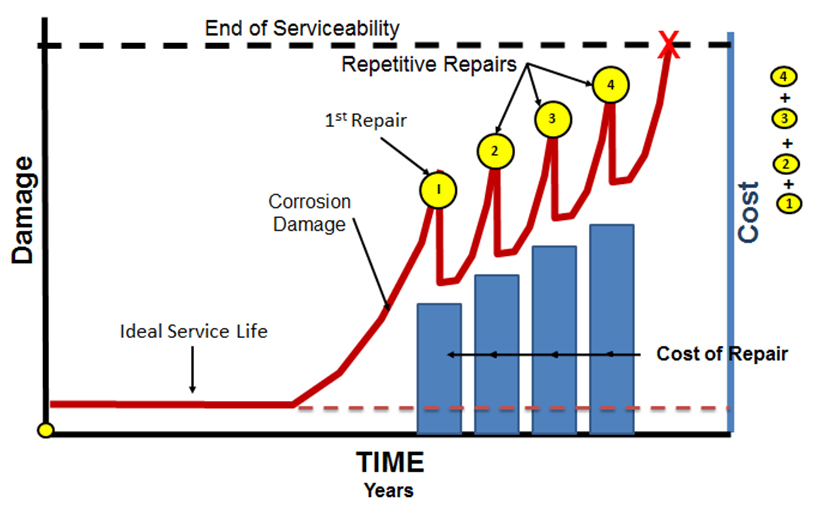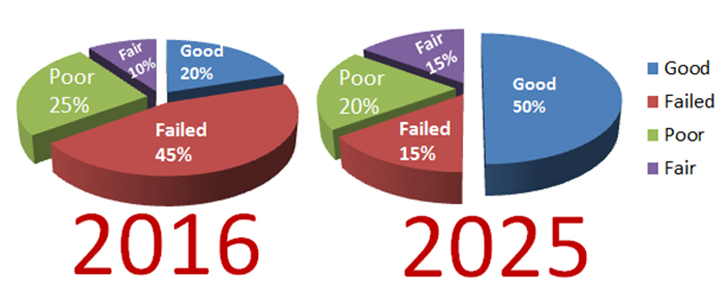| Dr. S. K. Manjrekar Managing Director Sunanda Speciality Coatings Pvt. Ltd. Honorary Member – American Concrete Institute |
Dr. R. S. Manjrekar Director Sunanda Speciality Coatings Pvt. Ltd. |
|||
Reinforced concrete has been a material of choice and is the second most consumed material per capita in the world after water. The Indian construction industry is set to rise from a value of US$ 428.1 billion today to US$ 563.4 billion in 2020(R¹). Exponential growth in Indian concrete construction over past 40 years has concurrently created very sizeable need as well as market for repairs related activities.
Size Of Repair Industry In India
In India repair industry is not organized. Hence the exact numbers on annual cost to owners/public funding for repair, protection and strengthening are not available. Today India is placing new concrete to the tune of approximately 1.75 – 2 billion m3/per annum which of course needs to be protected. As against if we look at already placed concrete in past 50 years, it would be 55 – 60 billion m3 which now needs much protection.
Essentially deterioration of concrete takes place due to environmental factors, damage caused to structures due to basic defects in the concrete structures and change of use which can take place subsequently. Almost all the concretes are made as per the structural requirement of each structure and most of its concrete is typically specified. These concretes have to use local material from multiple sources having different quality which can be marginal. Sometimes the mix designs also are not standard and at times one has to work at neck breaking speed for producing the output which results in accelerated construction processes but may sacrifice quality. Above factors lead to malfunctioning and early distress signs in a structure and have led to rise of repair industry which is likely to assume a form of a parallel industry to new construction industry. In India this market/industry though of a large size and spread over all the nooks and corners of the subcontinent, is not organized. Yet, the magnitude can be realistically worked out by interpolation as well as extrapolation. When interpolated with regards to the distress and the health of inventory over past 40 years, the annual cost to owners for repair, protection and strengthening could be estimated between US$ 40 to 45 billion.
Indian Repair Industry Scene And Why Has This Deterioration Happened?
- India is second largest manufacturer of cement. Hence total inventory of various structures is also large, major part of which is needing repairs after obvious distress signals followed by their health assessment.
- India has transitioned itself from 15 MPa to 60 MPa in the span of 50 years as a general trend, though till two decades ago prevailing strength was 15-25 MPa. This means inventory of lower grade structures exist as a legacy of the past.
- Low concrete cover, low w/c, site mixing, associated with chloride attack with advent of traffic jamming number of vehicles and continuous industrialization carbonation have worsened the scene.
- India is hot weather country and has a long coast of 7000 kms with high humidity and tropical climate. 35000 sq. kms coastal area is under constant attack of airborne chlorides.
Fig. 1: R1 – www.concareplus.com/technology.html
R2 – www.indianmirror.com
Current Practice And Status Of Repair In India
- To remove deteriorated loose concrete
- Expose corroded reinforcement
- Semblance of cleaning and removal of corrosion products on heavily corroded steel
- Use of chemical, rust removers to remove corrosion products on corroded steel rebars
- Use of bonding agents
- Use of specialty polymer mortars as per global industry norms/specifications
- Use of protective coatings
The exponential growth of repair industry and unsatisfactory performance in the past 40 years has resulted in highlighting several shortcomings and need for improvements in:
- Materials
- Design practices
- Installation procedures
- Contracting processes
- QA/QC procedures
- Education and allied several aspects
Despite challenges the growth in repair activity is continuous, because common man/client notices the manifestation of distress in the form of cracks, delamination, failure and even sudden collapse and seeks urgent attention to allay his fears about safety. Collapses at regular intervals along with life loss brings lots of visibility, hence alarm. A large inventory of the concrete in India is 10 years plus old. Most of this concrete was site mixed and without many controls. Naturally, it is more vulnerable to carbonation, chloride attack, loss of alkalinity and attack of other aggressive chemicals etc.
Longevity Of Repairs
The short life cycle of repairs is raising questions on the knowledge and awareness about the technical competencies of related personnel and agencies. Rebuilding of older structures is not the general norm. Hence structures are typically repaired and often re-repaired.
Engineering students as well as engineers are not taught concrete or the science of steel corrosion with a special emphasis on materials. Repair is not a subject taught in engineering schools. As a result many areas remain ‘grey’ due to lack of formal training, education, learning, ‘State of the Art’ procedures and hands on training etc. This results in short life cycle of the repairs.
Special repair materials like Polymers, Epoxies, Protective Coatings, Nano Materials etc. also are not part of academics of civil engineering students/engineers. (Probably not in other parts of the world as well).
Performance of Repairs
One of the largest inventory of concrete structures are with the U.S. Army Corps of Engineers and their experience is given in a Pie chart as referenced.
FIg. 2: Performance of RCC Structures Owned by US Army Corps of Engineers
That means even in an advanced country like USA, barely 50% of the repairs perform satisfactorily and remaining repairs fall into fair, poor, failed category due to the problems in design, installati-on, materials and other parameters.
Fig. 3: R3 – REMR – CS -2 Report
What could be the success rate in the repairs in India and why? Possible extrapolation of repairs in India is as under.
Whole Life Cost and Performance of Repairs
The analysis of re-repairs pattern shown in Fig. 4 by Tuutti is very applicable to repairs in India.
Fig. 4: R4 – Tuutti Kyosti, (1982) CBI Research Report 4:82, 304 p
However unorganized, repairs is a big industry in India and merits judicious attention to control the colossal loss to national wealth by avoiding frequent failures. Repair operations are extremely sensitive and important. Various steps involved in repair projects are dependent on the personal knowledge level of the specifier. More often the specifications are copied from one specifier/job to other. As a result, though, repairs intended to extend the service life, structures often seem to fail prematurely due to the improper strategy of repairs and lack of defined responsibility criterion.
Trained personnel are required but often semi-skilled persons replace trained ones due to which project suffers – but realization after the failure and the loss is irreversible. Some engineers though small in number charge only nominal fees which is not the accepted norm of repair industry. However, gullible people are victims to this and succumb by awarding the projects. These are particularly small sized projects. Similarly there are mushrooming repair chemical suppliers and they seem to indirectly advise the small client on using wrong chemicals in uneducated fashion. Hence a strategy is presented to increase the accountability of stake holders of repairs industry through understanding individual and collective responsibilities.
There are several operations needed in any repairs job depending on the type and extent of damage which are the stake holders mentioned above. Some of the stake holders are from following trades.
- Membranes, Sealants, Coatings
- Waterproofing
- Surface Preparation – Hydro/Shot Blasting/Chipping
- General Concrete Repairs
- Grouting/Crack Injection
- Foundation Underpinning
- Formwork
- Steel Placement
- Guniting/Shotcrete
- Post-Tensioning
- Underwater Repairs
- Cathodic Protection
- Industrial Floor Repairs
Hence comes the need of Specialist Contractors with their responsibility defined. Simultaneously the issue of the responsibilities of all concerned e.g. designers, contractors and government agencies comes in the picture. Individual repair projects are smaller in value as compared to new construction project. Hence, it will be difficult for government authorities to give the permissions and completion certificates for all these projects due to real time enormity of sheer numbers for the machinery to handle. However, it is imperative to make sure that consulting practicing engineer is specially trained and certified for repairs technology and practices as this is totally different science of civil engineering which deals with material properties and behaviour of the structure as a result of deterioration.
Fig. 5: Metaphoric Representation of Construction Industry
Special training courses/certification exams/eligibility criteria must be worked out. This is not difficult task as abundant reference material is available locally and globally. Otherwise in the absence of such unified procedure every qualified civil engineer will have to wear several caps like NDT expert, material specialist, corrosion experts etc. However, this is possible when the engineers are so qualified in multiple specialties. More often the story becomes like an Elephant and Six Blinds.
Required Action To Improve Performance Of Repairs In India
In India, due to unorganized nature of the industry and outdated methods of execution the performance would be still more marginal and can be illustrated as shown in fig. 5.
Individual repair contracts are smaller in value as compared to new projects and hence multi level supervision is difficult and uneconomical. Hence the final responsibility comes on the client’s appointed consulting engineer and the contractor. However, often times the entire (360°) idea about analytical, diagnostic and QC parameters for the contract both in prescriptive and performance format are not known to either the consultant or the contractor. This is more because of multifaceted complexity of the subject as well as ignorance.
The logical remedy can be achieved only by increasing awareness and defining responsibilities of all the stake holders in the repair industry.
There are several beneficiaries of repairs industry
- Engineers
- Testing companies
- Architects
- Educators
- Contractors
- Researchers
- Equipment suppliers
- Lawyers etc. and most importantly owners
- Material manufacturers
Most of the concerned stake holders in the industry are in dire need of upgrading their skills, State of the Art knowledge. At the same time individual and interdependent responsibilities of the stake holders also should be well defined so as to improve service life, reduce costs and reduce conflicts. Mere fixing responsibilities is not enough, but enlightenment is imperative.
Based on the actions above the repair Industry in India will hopefully improve to 20% success as under:
Fig. 6: Target Performance for Repair Industry in India
At various levels persisting attitudes of following age old procedures, equipments and materials is seen prevalent in India and needs to immediately change towards “State of the Art” approach. Appointment of specialty engineer which is by definition “Licenced Design Professional” shall be retained by a contractor as well as owner.
A devoted group having representatives of Contractors, Engineers, Material Manufacturers, Researchers, Educators, Owners, Material Scientists and Industry associations needs to be formed to resolve various problems and seek out the solutions. Looking at the size of the industry, a Nodal Federal Agency should also participate in the process to offer credibility and authority to the recommendations of the group. This would be a faster and far reaching approach than leaving the improvement issue for repairs industry to resolve. It must be made a time bound initiative in the interest of all stake holders. The draft of the code will be peer reviewed and then sent for wider circulation throughout the industry for suggestions.
This Task Group shall do an important job of developing a ‘VISION’ which will change periodically as this is ever-growing dynamic industry.
Various improvements would make qualitative difference and also bring about ‘total responsibility concept’ and will reduce –
- Mistakes in repair methods and choice of materials
- Poor Performance
- Poor Workmanship
The task group must look into finding better repairs methodologies that reduce costs by delaying or avoiding re-repairs and enhance service life. This vision accompanied by the goals will help the industry, client, research institutes, federal departments like roads, railways etc. and all the stake holders.
This subdivided vision statement can have further sub issues and some of them can be as
- Repairs industry must be made a fully organized sector by forming a federation or trade association.
- Indian repairs Industry should have outreach beyond civil engineering to establish mechanisms for inter-organizational and inter-disciplinary cooperation to create state of the art technology as well as its dissemination.
- Indian Concrete Repairs Institute (ICRI) will be formed on a national level which will have affiliations to other such global institution. This will facilitate Technology Transfer.
- Develop and implement the methodology to hasten documents creation and dissemination within industry stake holders.
- Create a repairs/rehabilitation code to enhance the evaluation, design, materials, field and inspection practices which raise the level of performance of repairs and protection systems.
- Establish clear responsibilities and authorities for all participants. This should provide the local government officials/authorities a guideline to issue licenses to concerned stake holders.
- Develop concurrently performance-based guide specifications for specific and generic repairs designs.
- This will instill the confidence in customer’s minds and also will bring a system to the approach of the repairs industry.
- Improve repair materials design and performance
– to eliminate cracking
– to carry structural loads
– to define properties of set and cured finished repairs - Develop environmental and worker friendly repairs methods, equipments and materials that will greatly reduce the adverse effects on workers, the public and the earth’s ecosystem.
- Develop a means for predicting repairs system performance to help ensure the use of proper materials, design details and installation methods based upon predictive models validated by experience.
- Develop and implement a strategic research plan for the repairs industry with University, Industry and Government (UIG) partnership.
- Create the conducive environments to increase the number of material, engineering and construction related professionals interested to upskill in repairs and protection practice. This will support the growing need of trained and qualified personnel for evaluation of design, new materials and construction practices related to repairs.
- Develop selection processes, contractual agreements, procurement methods and relationship arrangements (partnering) that will greatly reduce conflicts, rework, claims and lawsuits resulting from disagreements among contractors, general contractors, engineers and owners.
- Develop client education programs that will promote awareness of the effects of deterioration and the means to reduce the risks while protecting their investments.
- Develop improved means and methods for accurate and thorough condition assessment.
- Develop specific repairs system needs for expanded use, efficiency and failure reductions.
- Train and assimilate unorganized sector in the main stream by knowledge dissemination and inclusion in trade association. It would be a national program executed all over the country. Skilling is a large initiative taken by Federal Government of India with a special ministry.
- Evolve specifications and standards for the performance criteria of repairs, matching with international standards in collaboration with Bureau of Indian Standards (BIS).
- Members of the Industry should engage in continuous innovation, based on the conditions of Indian subcontinent as well as training the personnel/applicators on regular basis in a structured manner.
The strategy will keep evolving as it is just the beginning of making an incredibly large business more structured and responsible.
The vision 2025 will ascertain the improvement in the repairs performance by 2025 as under –
Fig. 7: Vision 2025 for Performance of Repairs in India
Important Note
This article is based on studies and personal experience of last three and half decades of the Indian scenario of repairs and exhaustive referencing done from the literature.
However, the conclusions and recommendations are entirely personal and based on self-experience on national and international projects. It means there can be another view point as well and which together would improve the performances of the repairs.
References
- R1 : http://www.concareplus.com/technology.htm
- R2 : www.indianmirror.com
- R3: REMR – CS -2 Report
- R4: Tuutti Kyosti, (1982) CBI Research Report 4:82, 304 p









